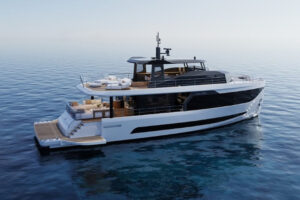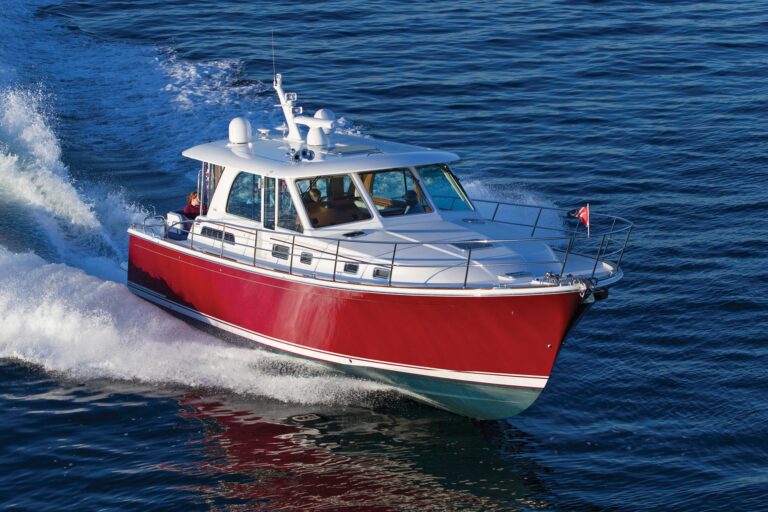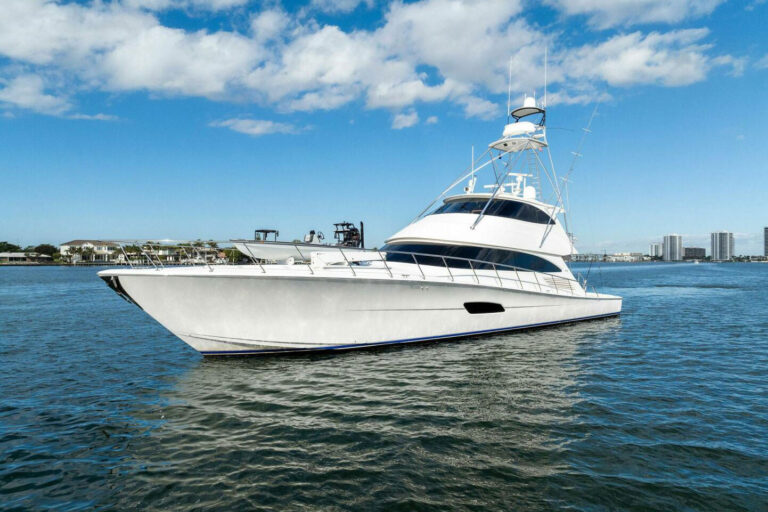
fairline643.jpg
Usually when I am doing a sea trial on a yacht I know within the first few minutes my feelings about the boat. In that short time I have picked up the emotion of the design and focused on the style. With this new ground-breaking design from Fairline, however, those initial impressions were missing and I soon found myself challenged and questioning my reactions. By the end of the sea trial, however, I found the new Targa 64 and its new ideas and concepts completely fascinating. It is a yacht that grows on you; I am sure it is the better for this.
It is interesting to see how style changes at a marque. Before this model Targa, the Fairline range was noted for a sharp exterior and a contrasting soft and curvy interior. With the 64 this has all changed. Now the curves are on the outside; now it is the interior that’s sharp and modern. What hasn’t changed is the deft handling of the yacht at sea: The deep-V hull is very sure-footed and responds to every command. We had lively, lumpy cross-seas on the sea trial off beautiful Monte Carlo and the 64 took it all in stride. Adding to the pleasure, noise levels were some of the lowest I have come across.
Yet at first, I confess, I felt a slight irritation at not having my usual Fairline before me, and I believe the interior was the cause. I am not a great fan of a style that uses wood veneers to create swoopy curves, and this is the style of the deck saloon of the 64. While I still miss the comfortable lived-in feel that you like to find in a yacht, I now have no doubts about the overall success of this remarkable design. It might even be said to have changed the face of what can be achieved with a modern sports cruiser.
Down below in the accommodation, there is pure unadulterated luxury. The master suite is superb, benefiting from the large side windows in the hull. It is divided into two parts, with the bathroom on the port side, divided from the main cabin by a glass screen and door, which allow sunlight in from the window on that side. The screen is special, made from electrochromatic glass that turns opaque for privacy at the touch of a switch. Wash basins have become a style statement in many motoryachts; in the 64 they go one step further than the rest by having a beautiful unit made from treated teak.
Forward from the master is a combined saloon and galley. In a sign of these culinary times, the galley plays the dominant role. There is everything you could wish for to launch a celebrity lunch, including a dishwasher and a twin sink. The oven, set almost at floor level, may require getting on your hands and knees to cook. (The same height/access issue tasks the washer/dryer installed under the access stairway.) As the seating in the saloon is limited to a corner settee that can hold at maximum four, you may feel the urge to find a less cramped place to relax than this vestibule/galley.
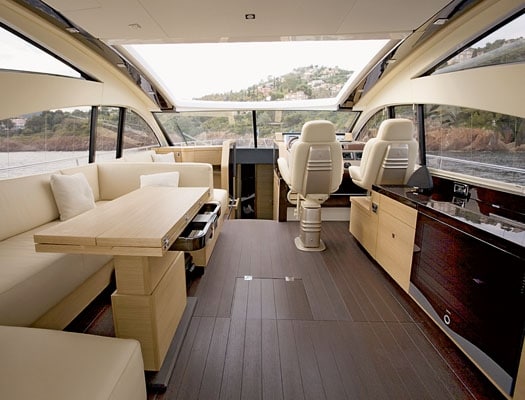
| | |
A good option would be either of the twin cabins on the port side or the VIP cabin forward. These forward cabins are endowed with the same high degree of luxury as the master; there will be no complaints about the quality here. There is good natural light in each as well, from overhead deck windows. Doors lead off from all three to the shared head that is also the day head; sorry, no teak wash basin! But it is spacious and practical.
A variety of textures and finishes are used for a fresh modern look: panels of smoked acrylic combined with fabric and wood, the latter contrasting dark Wenge and light straight-grain oak. Up in the deck saloon, lacquered panels are added to the mix as well.
You can picture the inside galley saloon being relegated to a passageway role once you see the deck saloon. The deck saloon is the unquestioned focus of social life on board. A settee surrounding a versatile table can open out and be raised and lowered via electronic control. The table faces a TV that rises out of the starboard side; here there is also a cocktail bar that includes an ice-maker. The saloon deck is at the same level as the cockpit so when the rear doors are opened you have one continuous space. I only wish this continuity of space could have been extended by taking the teak used on the cockpit deck and carrying it through to the saloon.
As it is, the cockpit has been dedicated to comfort and intimacy with two settees and a large bar and barbecue counter that comes complete with fridge and electric burner. In warm climes this will inevitably become the focus of relaxation.
It is obvious that a lot of thought has gone into the design of the helm. Two electrically adjustable seats are installed and it is possible to get in and out of the second seat without disturbing the driver. Most people will be able to find the seat position that suits their own driving comfort needs. For me, despite their wide range of adjustment, I did not find a comfortable driving position in which the angled footrest exactly matched up to the seat; eventually I found that standing up while leaning back on the seat was best. The problem was if I did this the low top to the windscreen blocked my view. Above me, a huge sunroof opened at the touch of a button, and if I stood on the seat’s footrest I could look over the windscreen top rail just fine. But then it was hard to reach the wheel. So while the potential in the helm area is there, I can’t help feeling that it needs another design tweak.
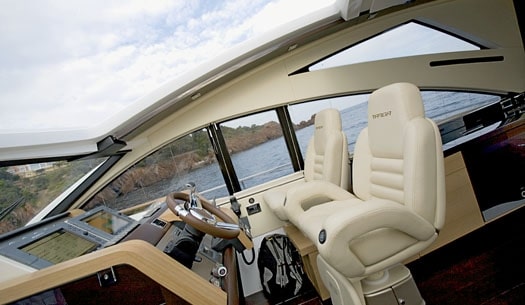
| | |
The helm itself is divided logically into various areas with the main controls mounted on a center island with the wheel on the left. Above this are the two main electronic navigation displays that can be made to disappear under electric control to leave a flat surface; then the dash terminates in a row of analogue engine dials. The light oak trim around the dash does cause some reflections in the windscreen but overall it is easy and logical to find the information and controls that you need. Over to port is a corner settee for guests; proper sea seating might be a better option here. (As would more handholds in the deck saloon, a pity for what is otherwise a good practical boat.)
For sun-worshippers there is a sunbed aft and another on the foredeck, which has very smart teak deck trim. There are generous lockers for rope and fender stowage and a cockpit liferaft. Below the aft sunbed is a tender garage and the 64 has a superb and safe-feeling passerelle.
The power for this beauty comes from a pair of 1,100-hp MAN diesels with the option of 1,015-hp Cats. These connect to a conventional shaft and propeller system with the propellers in semi-tunnels. The engine compartment is compact due to the garage intruding on the available space, but access is good.
The real pleasure of this design is found when you go to sea. Here the 64 is really in its element. In fact, it was the sea trial that answered all my questions about this yacht, and from that point on, with such good performance, I came away loving the concept. Although I am hoping that the designers will tighten up some of the small issues, as the boat tested was the first one out of the factory I think it will only get better. I also think that Fairline has moved the design of sports cruisers forward with this innovative design while retaining the classic good looks that are a British tradition and Fairline trademark.
To read more about Fairline’s history, click here.
To read about the Fairline 74, click here. For a gallery of the 74, click here.


